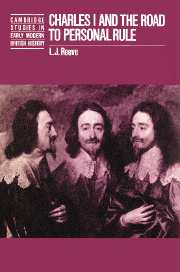Book contents
- Frontmatter
- Contents
- Acknowledgements
- List of abbreviations
- 1 Introduction
- 2 Buckingham's England in crisis
- 3 The death of a Parliament
- 4 The aftermath
- 5 Government and justice
- 6 The king, his court and its enemies
- 7 Foreign policy
- 8 Decision
- 9 The anatomy of a political transition
- Bibliography
- Index
- Cambridge Studies in Early Modern British History
6 - The king, his court and its enemies
Published online by Cambridge University Press: 13 October 2009
- Frontmatter
- Contents
- Acknowledgements
- List of abbreviations
- 1 Introduction
- 2 Buckingham's England in crisis
- 3 The death of a Parliament
- 4 The aftermath
- 5 Government and justice
- 6 The king, his court and its enemies
- 7 Foreign policy
- 8 Decision
- 9 The anatomy of a political transition
- Bibliography
- Index
- Cambridge Studies in Early Modern British History
Summary
The emerging character of the Caroline regime, of its policies in Church and state, was definitely discernible by 1630. That character was very much the product of Charles's personality, of his views, and of the efforts of those in government who shared them. The king was the guiding spirit, not by virtue of charisma, but because he was the legally rightful ruler of his people. Charles's title to the kingdom did not, however, mean that he shared in the necessary qualities of kingship. It is appropriate to dwell here on the character of Charles Stuart the man, before examining the circles in which he chose to move. The highly emotive circumstances of Charles's eventual death, and the dignified bearing which, amid them, he achieved, have often overshadowed the shortcomings of his rule and their role in creating the tragedies of his reign. Above all, there is a complexity – and inscrutability – about Charles which has hampered our historical understanding. These elements were reflected in the ambivalence with which those who had served him, even for years, summed up his character. Laud saw Charles as a mild and gracious prince who knew not how to be or be made great. Sir Philip Warwick regretted the way in which the king, admittedly in the latter days of the civil war, could be temperamental and uncommunicative in Council. Clarendon, at pains to point out Charles's merits as man and king, was forced to conclude unhappily: ‘His kingly virtues had some mixture and allay that hindered them from shining in full lustre, and from producing those fruits which they should have been attended with.’
- Type
- Chapter
- Information
- Charles I and the Road to Personal Rule , pp. 172 - 225Publisher: Cambridge University PressPrint publication year: 1989

